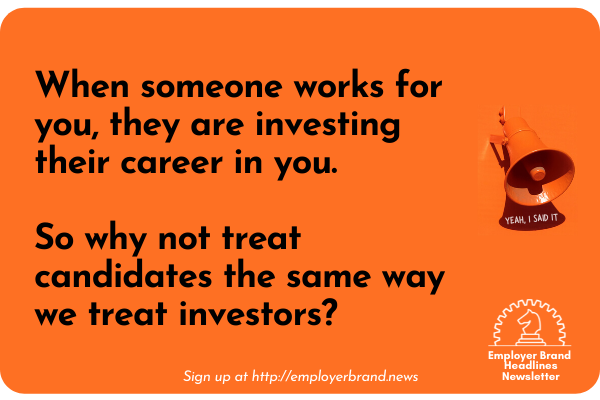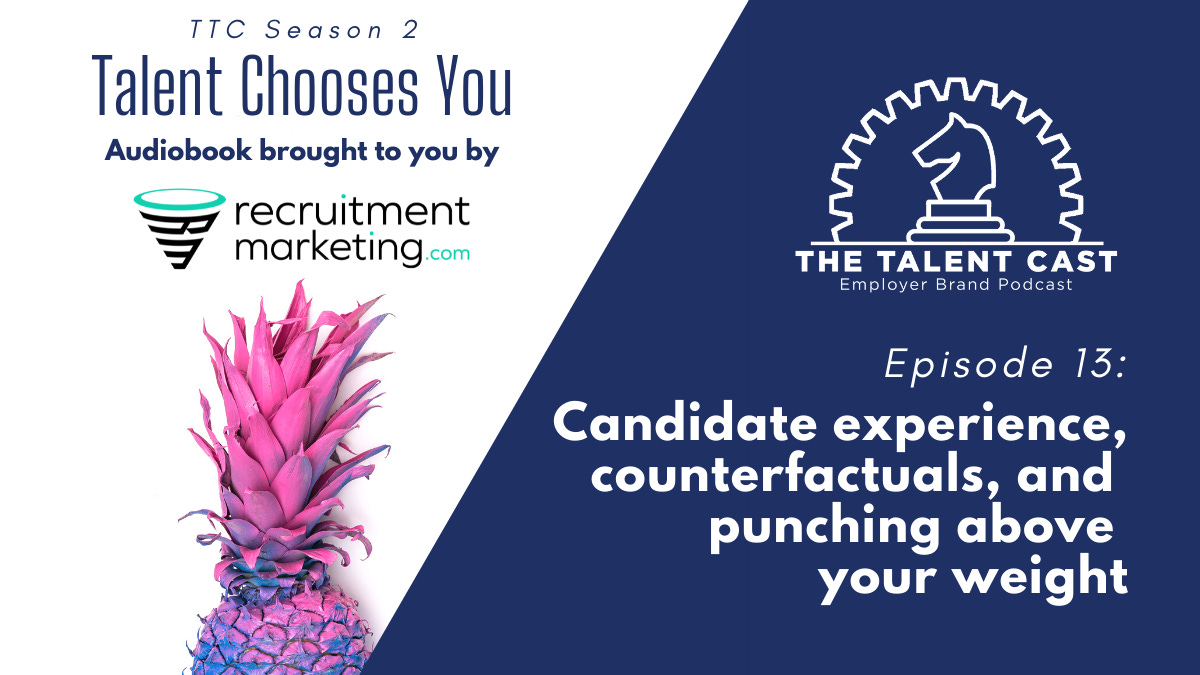♟️ Employer Brand Headlines #141: The "Happiness Is Easy" Edition ♟️
What if your employees are the most important investors you have?
Mission: Blow up the standard for what people expect from employer branding
Employer Brand Headlines is brought to you by James Ellis. Say hello!
In this issue…
Candidates are investors
Organizational gaslighting
Starting with no
Responding to unreasonable requests
The big idea
I was kinda planning on going deeper on the employer brand manifesto from last week, but something hit me during a walk to the paint store (don’t ask) and I wanted to capture it before I lost the core idea.
There are lots of ways to think about candidates and recruiting. Everyone’s favorite (or the most often used) is that hiring is like dating: Initial interest is a spark that leads to a journey in which both sides evaluate the situation to decide if they want to make a long-term commitment to each other.
Of course, there’s the old chestnut that recruiters are like sales people, leveraging a combination of cold outreach and networks to identify and engage potential “buyers” of a role. The process is a relatively long sales cycle, but the goal is to move the prospect to the next step in the funnel and “close” them.
You can probably have a few of your own to deploy when someone (often a hiring manager) asks you to “just promote the job to more job boards” or some such. The metaphor is the means by which you help people who don’t know, get what you do.
But metaphors are amazing things. Yes, they can work to help you describe something new, but they can also help you re-think how you see something right in front of you.
When someone joins your company, they are making a choice. More than that, they are expressing a view of the future. While they are deciding that this company is right for them now, they are selecting it because they see a brighter future with the company. Perhaps the company is going to grow and take them (and their stock price) with them. Perhaps the company is in a market the candidate thinks will elevate them. Perhaps the company offers benefits and values that will allow the person to have a better life.
If you remove the word “candidate” from the above idea, that the person is selecting a company because they see that it will help their future, you are really talking about an investor, are you not?
Investors look a a company and chose to invest in it because they see how it will be better tomorrow. The investment itself is a prediction in how the future will play out.
So let’s go talk to our local investment relations (perhaps your company has one). What would we see?
An insane amount of work in documenting the company on a regular basis for the wider world to understand what the company is doing and how it sees the future (SEC filings, quarterly earnings results, etc).
Quarterly open phone calls in which the top execs discuss the past 3 months, and answer questions from shareholders and reporters, all recorded and available for review by anyone.
Regular personal contact with larger investors, including longer meetings where the investor might question the IR manager about the state of the market, the state of the business, and if the business has what it needs to grow.
Additional reporting materials like ESG/CSR reports and annual reports, which are often expensively built with a specialist design agency and disseminated to investors and prospects globally.
Regular presentations at by-invitation conferences that are often simulcast and webcast.
All of this effort (and money!!!) is designed with the single goal of making people believe the company is on the right path forward so that they feel comfortable investing.
But what if we treated candidates like investors? What if we gave them all the information on a regular basis that investors get? (It would make for a compelling reason to post salaries on every job, right?) What if the CEO and other executives were empaneled to answer candidate questions publicly on a regular basis? What if the same effort and care was made in content creation and narrative-development as in the investor side of things?
Your instinct might be to justify the effort by saying, “sure, the company invests a lot in IR: they are convincing people to invest millions of dollars at a pop, and failure to get investments might lead to the failure of the company.”
While an investor might buy a million dollars worth of stock or bonds, they have millions more in other investments, either to bolster the expression of the future, or to hedge that bet. No investor, regardless of size, puts all their chips on one play. They distribute the risk.
But candidates don’t have that opportunity. They can’t take multiple jobs and hope one pays out. They are probably full-time employees who aren’t hourly, so are expected to spend all their time creating value to their employer. Maybe they had to sign a no-moonlighting contract, guaranteeing that the employee couldn’t hedge their bets.
As to value, while a great employee makes or breaks a company, there is no company without people. Your people are your most important investment (ahem… right?), so invest in the hiring of them like you invest in the attraction of new investments.
I’m not saying we need to gut the IR team, I’m saying that looking at what the IR team does, and how closely it resembles how you’d want to recruit might lead you to see your employer branding work in a whole new light.
Yep, we’re still podcasting about a book.
The revised and annotated audio version of Talent Chooses You (recorded in Q Sound) continues with episode 13 with a deep dive into how any company can compete for talent with any other company.
Headlines!
Measuring Branding Success
Everyone wants to talk about how to measure your employer brand. That’s the wrong question. The right question is: what do you want your brand to DO? Once you know that, you can figure out how to measure it. [Business Strategy Insider]
How to Use a Candidate’s ‘No’ to Strengthen Your Employer Brand Strategy
There’s a ton of useful intel from the people who don’t take the offer. But you gotta go get it, first. [CEO World]
How comms pros can prevent ‘organizational gaslighting’
Um… let’s not ascribe this to the comms team, shall we? There’s a lot of blame to go around. [Ragan]
Where is the office now?
There are more options than ever on where a job might exist. That means you will need to spend a little extra time explaining where your job is and why it is there. [strategy+business]
The Neuroscience of Customer Experience
Don’t bother reading this. We all know your candidates don’t have emotions and process all information perfectly rationally… assuming you even put all the information out there [MIT Sloan]
Persuading Your Team to Embrace Change
I think I say this once a month in this newsletter, but 100% of your job is to create change within your organization. That means you need to get really good at helping others embrace change. [HBR]
10 Things to Do in Your First 100 Days as a New Employer Brand Professional
I 100% agree with the points in this article, I just wish they dove in a little more deeply. I mean, we all want executive buy-in and should do target audience research, but just listing is as a “to do” when you start isn’t enough. [Exaqueo]
10 Ways To Ignite And Build A Brand Movement
While it’s a little harder than what this checklist might suggest, isn’t “movement building” something we should all be trying to achieve? [Brand Strategy Insider]
How to build an employer brand that everyone wants to work for
I honestly don’t think it’s possible to build an authentic brand everyone wants to work for. Also, I don’t think you should want to. [LinkedIn]
How to Ask Whether an Employee Is Happy at Work
You really wanted the answer to be “send a survey,” didn’t you? Me, too. [HBR]
CTR/ER doesn’t correlate with any meaningful marketing outcomes
This isn’t me saying it. It’s the head of development at LinkedIn [LinkedIn]
How to Respond to an Unreasonable Request
Feel free to throw this link on your recruiting Slack channel with your “knowing” emoji of choice [HBR]
Inside the fortune cookie
“If you don’t make a mistake, you’re not trying hard enough.” - Charlie Parker
Thanks, everyone!
Search the 1,400 links in the newsletter archive.
Read Talent Chooses You for free from this open source Google Doc
If you have a question, just reply to this email and it comes directly to me.
Cheers and thanks!
-James Ellis (LinkedIn | Twitter | Podcast | Articles)
Where the subject line came from:
Happiness Is Easy - Talk Talk
One of my pet theories is that employer branders aren’t artists, they are producers. The are seeing a wide range of ideas, tactics, channels, and people and suggest new ideas to make the best possible brand. Just like Brian Eno nudging Bowie or U2 with little ideas, helping them create their best work of their career. (related: there should be more books from music producers.) That might explain why I’ve not listed two Talk Talk songs in a row from the same album. Coming off two well-received synth-pop albums, they took this insane left turn into pastoral, acoustic, verdant and progressive pop. And it is absolutely beautiful work to listen to, with instruments popping in for a beat never to be heard again, all on how of the soft notes of the Hammond organ and acoustic guitar/bass tracks that just jumps out at you. Enjoy.
If you are enjoying the music, congratulations, you’re old. I made a Spotify playlist of all the subject line songs I’ve used over the last year and a half:








